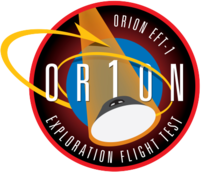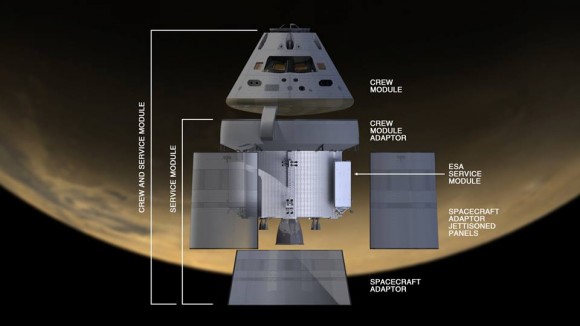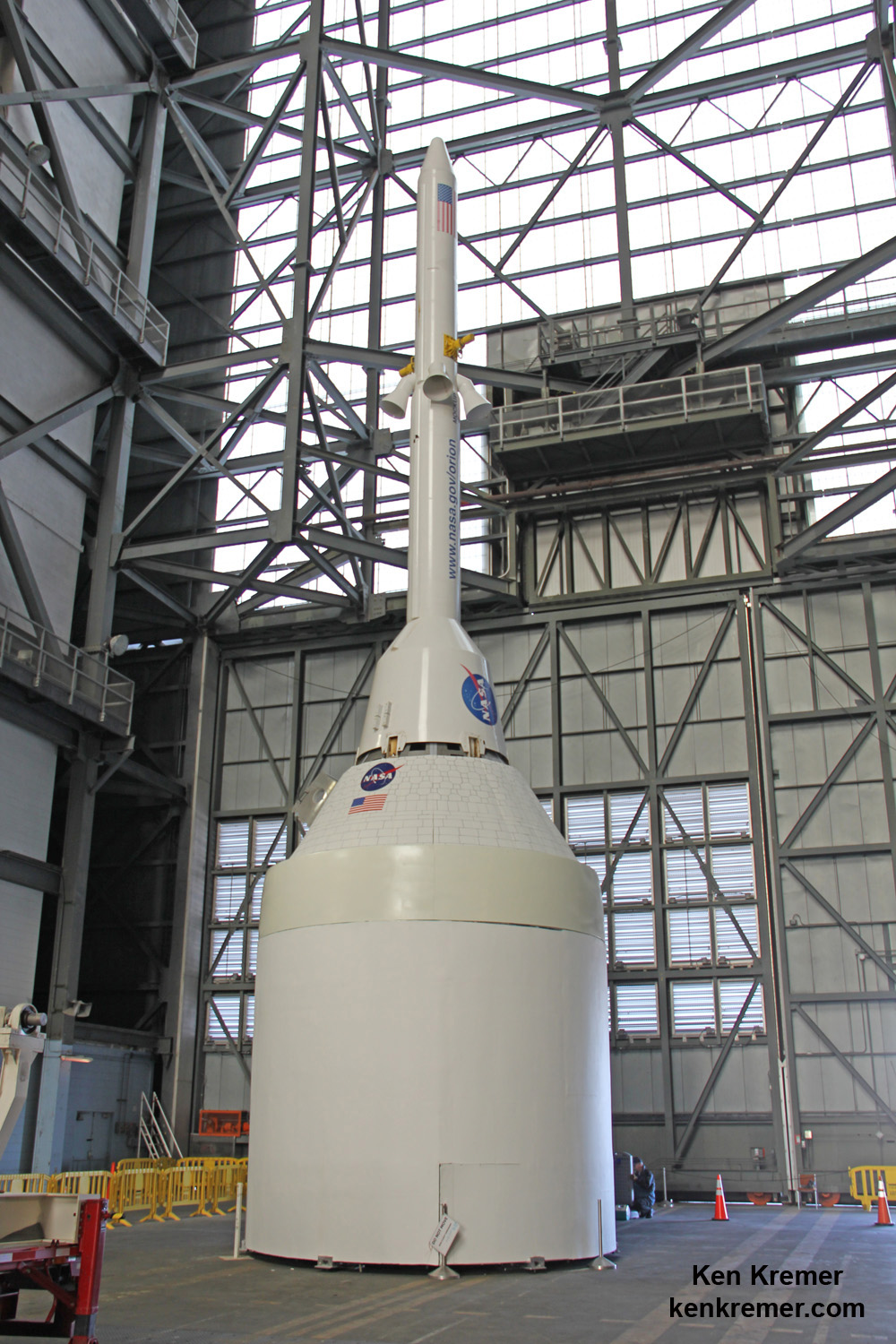ShopDreamUp AI ArtDreamUp
Deviation Actions

Exploration Flight Test 1 or EFT-1 (previously known as Orion Flight Test 1 or OFT-1) is the first planned uncrewed test flight of the Orion Multi-Purpose Crew Vehicle. Set to launch in 2014 atop a Delta IV Heavy from Space Launch Complex 37 at Cape Canaveral Air Force Station, the mission will be a multi-hour, two-orbit test of the Orion Crew Module featuring a high apogee on the second orbit and a high-energy reentry at around 20,000 mph. This mission design is essentially equivalent to that of the Apollo 4 mission of 1967, which validated the Apollo flight control system and heat shield at re-entry conditions planned for the return from lunar missions.
After splashdown in the Pacific Ocean, crews will recover the EFT-1 Orion crew vehicle and outfit the capsule for an ascent abort test. The spacecraft will remain attached to the Delta IV's Upper Stage until reentry begins and will rely on internal batteries for power rather than photovoltaic arrays, which will not be installed. The flight is intended to test various Orion systems, including avionics, heat shielding and parachutes prior to its debut launch aboard the Space Launch System, currently scheduled for late 2017.
EFT-1 Orion is being built by Lockheed Martin. On 22 June 2012, the final welds of the EFT-1 Orion were completed at the Michoud Assembly Facility in New Orleans, Louisiana. It was then transported to Kennedy Space Center's Operations and Checkout Building, which is where the remainder of the spacecraft will be completed.
Data gathered from the test flight will be analyzed by the Critical Design Review (CDR) in April, 2015.


UPDATE 1:
The pieces are coming together for NASA's newest spaceship Orion, with its first unmanned launch test scheduled for September 2014. The Orion space capsule is designed to carry humans farther into the solar system than they've ever been by taking trips to the moon, asteroids and Mars. It will be the first new spaceship built by NASA since the space shuttle was developed in the 1970s. The space agency is planning to outsource travel to low-Earth orbit, including the International Space Station, to the private space sector, allowing NASA itself to focus on traveling beyond.
"I think having a test flight in '14 is huge — people can see it right there," Orion program manager Mark Geyer told SPACE.com in September. "It's a really important goal.
Orion was originally conceived as a next-generation spacecraft, called the Orion Crew Exploration Vehicle, under NASA's now-defunct Constellation program. When that program was cancelled by the Obama administration, the Orion design was carried forward as the Orion Multi-Purpose Crew Vehicle.
The engineering team behind the capsule has weathered political ups and downs, but say they are glad to be approaching flight time for the craft.
"It's hard to put in 80 hours a week and then have somebody go, 'I don’t want to do that anymore,'" Geyer said. "We kind of went through that two years ago, but fortunately we came out on the other side."
Orion first test flight will be called the Exploration Flight Test 1 (EFT 1), and will include a test of more than half the systems that will appear in the ultimate finished Orion. These include its heat shield, which is a totally novel design made of a special composite material and an ablative coating deigned to burn off as the capsule re-enters Earth's searing atmosphere for the trip home. EFT 1 will also test the capsule's primary structure design and put its avionics and computer systems through their paces.
However, for this first flight test Orion will ride to space aboard a Delta 4 heavy rocket — a proven flight vehicle from ULA (United launch Alliance) that won't be its ultimate booster. Eventually, Orion is planned to launch toward the moon and beyond on NASA's Space Launch System (SLS), a new heavy-lift rocket still under development. The first flight test for Orion and SLS together, called Exploration Mission 1, is slated for 2017. Orion and SLS are set to carry humans onboard for the first time in 2021.
On the surface, Orion looks like a modernized Apollo capsule. Both vehicles are cone-shaped and launch vertically atop heavy-lift rockets. However, the similarities are only skin deep. Where Apollo could carry three astronauts to the moon, Orion is bigger and can take four. The 1960s-era Apollo capsule featured computer technology inferior to that of a smart phone, while Orion is controlled by state-of-the-art technology. Its heat shield is composed of entirely new materials, and many other features are wholly novel.
"It's kind of like an automobile in 1905 had four tires and a steering wheel, and they still do now," Geyer said. "But none of the stuff inside is the same."
Between now and EFT 1, the NASA teams are working with the capsule's prime contractor, Lockheed Martin, to finish construction of Orion's systems and assemble them together. The primary body for that test vehicle is finished, while the heat shield still needs about six months more. Its avionics computers are undergoing testing now. Eventually, the whole vehicle will be put together in Florida at NASA's Kennedy Space Center in Cape Canaveral.
"I think we have a great design and we have a great plan to fly it," Geyer said. "It's time to do it, to actually put it to use and put it in the missions that are going to let us discover new things."

A mockup of the Orion capsule at NASA’s Johnson Space Center in Houston. (Photo: NASA)
UPDATE 2:
Orion Crew Module Undergoes Static Load Tests
Completely surrounded by a massive 20-foot-high structure called the crew module static load test fixture, the Orion crew module is being put through a series of tests that simulate the massive loads the spacecraft would experience during its mission.
Orion is NASA’s new exploration spacecraft, designed to carry humans farther into space than ever before. During its first flight test next year, Exploration Flight Test-1 (EFT-1), it will travel 3,600 miles into space and return to Earth. This will allow NASA to evaluate Orion’s performance in preparation for future deep space journeys.
Lockheed Martin Space Systems began static loads testing May 3 on the Orion EFT-1 crew module inside the Operations and Checkout (O&C) Building at Kennedy Space Center in Florida. Technicians will use hydraulic cylinders to slowly apply pressure to various areas of the vehicle to simulate the loads it will be exposed to at different phases of the mission.
The tests will run throughout May and June, with different phases simulating launch, ascent, launch abort, launch abort system separation, reentry and landing. Lockheed Martin is conducting the tests based on a set of prototype flight requirements.

Image above: In the Operations and Checkout Building at the Kennedy Space Center, the Orion crew module is secured on the static load test fixture in preparation for a series of tests that will simulate the massive loads the spacecraft would experience during its mission. Photo credit: NASA/Kim Shiflett
UPDATE 3:
Heat Shield for NASA's New Orion Spacecraft Set for 2014 Test Flight
Work on the heat shield for NASA's Orion Multi-Purpose Crew Vehicle — America's next-generation spacecraft that could transport astronauts on missions to Mars — is on track toward an ambitious test launch in 2014.
Since spring, teams of engineers and technicians from Massachusetts-based Textron Defense Systems have been meticulously applying Avcoat, a proprietary thermal ablation and insulation material, to the heat shield, which will protect the Orion capsule and its crew from the extreme heat generated during high-speed re-entry into the atmosphere after a deep-space flight.
At 16.4 feet (5 meters) in diameter, the Orion heat shield is the largest and most advanced composite heat shield ever built. Textron originally developed the lightweight Avcoat ablative material in the 1960s for use on the Apollo command module.

Made of epoxy novolac resin in a fiberglass honeycomb matrix, Avcoat works by "burning off" as it heats up, dissipating thermal energy away from the capsule's structure. The material had a 100 percent success rate during the Apollo, Skylab and Apollo-Soyuz programs, safely leading astronauts to 15 ocean splashdowns, and was thus chosen for the job of protecting Orion and its future crews as they head off to destinations never before visited by humans.
"Avcoat is the only man-rated ablative material that exists today," Ian Walsh, Textron Defense System's senior vice president and general manager, told SPACE.com. "We are proud to provide this state-of-the-art technology to NASA and help the country push the boundary of space exploration to the next level with our thermal protection material."
After Textron completes applying the Avcoat, the shield will be flown down to Cape Canaveral, Fla., where it will be mated to the bottom of the Orion crew module for its 2014 orbital test flight.
Update 4: L- 11months
NASA's first-ever deep space craft, Orion, has been powered on for the first time, marking a major milestone in the final year of preparations for flight.
Orion's avionics system was installed on the crew module and powered up for a series of systems tests at NASA's Kennedy Space Center in Florida last week. Preliminary data indicate Orion's vehicle management computer, as well as its innovative power and data distribution system -- which use state-of-the-art networking capabilities -- performed as expected.
"It's been an exciting ride so far, but we're really getting to the good part now," said Mark Geyer, Orion program manager. "This is where we start to see the finish line. Our team across the country has been working hard to build the hardware that goes into Orion, and now the vehicle and all our plans are coming to life."
Throughout the past year, custom-designed components have been arriving at Kennedy for installation on the spacecraft -- more than 66,000 parts so far. The crew module portion already has undergone testing to ensure it will withstand the extremes of the space environment. Preparation also continues on the service module and launch abort system that will be integrated next year with the Orion crew module for the flight test.
Update 5: L- 11months
Launch of America's next space program is slated for September 20th, 2014!!!
Update 6: L- 10months
Orion's Heat Shield is being offloaded from the NASA's Super Guppy here at the Kennedy Space Center


Update7: L-7 months
The Orion spacecraft has moved another step closer toward its first test flight as the core and starboard boosters for the United Launch Alliance (ULA) Delta IV Heavy rocket contracted by Lockheed Martin for that flight have arrived to Cape Canaveral Air Force Station. The rocket will undergo testing and processing at ULA’s Horizontal Integration Facility to prepare for Orion’s Exploration Flight Test-1 later this year.
Technicians offloaded the boosters from a specially designed ship called the Delta Mariner, which had traveled 8 days to Florida from the ULA facility in Decatur, Ala. where the rocket is manufactured. Once in the Horizontal Integration Facility, processing and testing will be completed in preparation for rolling the Delta IV Heavy out to Space Launch Complex 37 for launch.


Update8: Launch has been moved to December 4th
Update9: L-6 months

KENNEDY SPACE CENTER, FL- Engineers have begun stacking operations for NASA’s maiden Orion deep space test capsule at the Kennedy Space Center (KSC) achieving a major milestone leading to its first blastoff from the Florida Space Coast less than six months from today.
The excitement is mounting as final assembly of NASA’s Orion crew vehicle into its launch configuration started on Monday, June 9, inside the Operations and Checkout (O&C) Facility at Kennedy.
Orion will eventually carry humans to destinations far beyond low Earth orbit on new voyages of scientific discovery in our solar system.
“Orion is the next step in our journey of exploration,” said NASA Associate Administrator Robert Lightfoot at a recent KSC media briefing.
“This mission is a stepping stone on NASA’s journey to Mars. The EFT-1 mission is so important to NASA.”
Orion is slated to launch on its inaugural unmanned test flight in December 2014 atop the mammoth, triple barreled United Launch Alliance (ULA) Delta IV Heavy rocket.

The main elements of the Orion spacecraft stack include the crew module (CM), service module (SM) and the launch abort system (LAS).
On Monday, technicians from Orion’s prime contractor Lockheed Martin began aligning and stacking the crew module on top of the already completed service module in the Final Assembly and System Testing (FAST) Cell in the O & C facility at KSC.
“Ballast weights were added to ensure that the crew module’s center of gravity can achieve the appropriate entry and descent performance and also ensure that the vehicle lands in the correct orientation to reduce structural impact loads,” according to Lockheed Martin.
Engineers will remain busy throughout this week continuing to work at a 24/7 pace to get Orion ready for the December liftoff.
The next steps involve completing the power and fluid umbilical connections between the CM and SM and firmly bolting the two modules together inside the FAST cell.

Orion crew capsule, Service Module and 6 ton Launch Abort System (LAS) mock up stack inside the transfer aisle of the Vehicle Assembly Building (VAB) at the Kennedy Space Center (KSC) in Florida. Service module at bottom. Credit: Ken Kremer/kenkremer.com
An exhaustive series of electrical, avionic and radio frequency tests will follow. The team will then conduct final systems checks to confirm readiness for flight.
The LAS will then be stacked on top. The entire stack will then be rolled out to the launch pad for integration with the Delta IV Heavy rocket.
The CM/SM stacking operation was able to move forward following the successful attachment of the world’s largest heat shield onto the bottom of the CM in late May.
“Now that we’re getting so close to launch, the spacecraft completion work is visible every day,” said Mark Geyer, NASA’s Orion Program manager in a statement.
“Orion’s flight test will provide us with important data that will help us test out systems and further refine the design so we can safely send humans far into the solar system to uncover new scientific discoveries on future missions.”
Orion is NASA’s next generation human rated vehicle now under development to replace the now retired space shuttle. The state-of-the-art spacecraft will carry America’s astronauts on voyages venturing farther into deep space than ever before – past the Moon to Asteroids, Mars and Beyond!
No humans have flown beyond low Earth orbit in more than four decades since Apollo 17, NASA’s final moon landing mission launched in December 1972.
The two-orbit, four- hour EFT-1 flight will lift the Orion spacecraft and its attached second stage to an orbital altitude of 3,600 miles, about 15 times higher than the International Space Station (ISS) – and farther than any human spacecraft has journeyed in 40 years.
One of the primary goals of NASA’s eagerly anticipated Orion EFT-1 uncrewed test flight is to test the efficacy of the heat shield in protecting the vehicle – and future human astronauts – from excruciating temperatures reaching 4000 degrees Fahrenheit (2200 C) during scorching re-entry heating.
At the conclusion of the EFT-1 flight, the detached Orion capsule plunges back and re-enters the Earth’s atmosphere at 20,000 MPH (32,000 kilometers per hour).
“That’s about 80% of the reentry speed experienced by the Apollo capsule after returning from the Apollo moon landing missions,” Scott Wilson, NASA’s Orion Manager of Production Operations at KSC, told me during an interview at KSC.
A trio of parachutes will then unfurl to slow Orion down for a splashdown in the Pacific Ocean.
The EFT-1 mission will provide engineers with critical data about Orion’s heat shield, flight systems and capabilities to validate designs of the spacecraft, inform design decisions, validate existing computer models and guide new approaches to space systems development. All these measurements will aid in reducing the risks and costs of subsequent Orion flights before it begins carrying humans to new destinations in the solar system.
“We will test the heat shield, the separation of the fairing and exercise over 50% of the eventual software and electronic systems inside the Orion spacecraft. We will also test the recovery systems coming back into the Pacific Ocean,” said Lightfoot.
“Orion EFT-1 is really exciting as the first step on the path of humans to Mars,” said Lightfoot. “It’s a stepping stone to get to Mars.”
“We will test the capsule with a reentry velocity of about 85% of what to expect on returning [astronauts] from Mars.”

SpaceX to Launch First NASA Astronauts since 2011
Launch America!
:thumb637657478::thumb637616207:
Published on Apr 19th, 2020 | NASA
A new era of human spaceflight is set to begin as American astronauts once again launch on an American rocket from American soil to the International Space Station as part of NASA’s Commercial Crew Program. NASA astronauts Robert Behnken and Douglas Hurley will fly on SpaceX’s Crew Dragon spacecraft, lifting off on a Falcon 9 rocket at 4:32 p.m. EDT May 27, from Launch Complex 39A in Florida, for an extended stay at the space station for the Demo-2 mission. The specific duration of the mission is to be determined.
As the final flight test for S
Apollo 13: Home Safe
Published on Apr 10th, 2020 | NASA
"Houston, we've had a problem." Apollo 13 has become known as “a successful failure” that saw a safe return of the crew in spite of a catastrophic explosion in the middle of their lunar journey. This 30-minute documentary features interviews with Apollo 13 Astronauts Jim Lovell and Fred Haise, as well as Flight Directors Gene Kranz and Glynn Lunney, with engineer Hank Rotter. Parts of their interviews take place in the restored Apollo mission control room. This documentary also features original NASA footage and newly synchronized audio from Mission Control.
Thanks to Stephen Slater and Ben Fei
The Worm is Back!
April 2, 2020 | NASA
Sightings of the NASA logotype (the "worm"), from left: Astronaut Mae Jemison preparing for launch; astronaut Bruce McCandless on an untethered spacewalk; the Hubble Space Telescope; astronaut Guy Bluford; and astronaut Sally Ride. Credits: NASA
The original NASA insignia is one of the most powerful symbols in the world. A bold, patriotic red chevron wing piercing a blue sphere, representing a planet, with white stars, and an orbiting spacecraft. Today, we know it as “the meatball.” However, with 1970’s technology, it was a difficult icon to reproduce, print, and many people considered it a complicated
COVID-19: How Aviation is Fighting for Survival
Published on Feb 1st, 2020 | Wendover Productions
As you all are well aware of by now the aviation community has been greatly impacted by CoVid-19, or as I like to call it, the CCP (Chinese Communist Party) Corona Virus. Within the last few weeks this virus has impacted everyday life in unimaginable ways, with aviation being one of the hardest hit by this pandemic. Airlines both in the United States and globally have had to slash their domestic and international fleets to curb operating costs and stay afloat in these uncertain times. United Airlines in particular has slashed it's domestic fleet by 42% and has plans to cut it further to 68% i
Featured in Groups
© 2013 - 2024 NASA-Headquarters
Comments10
Join the community to add your comment. Already a deviant? Log In
Finally back to true Space Exploration!!!!
